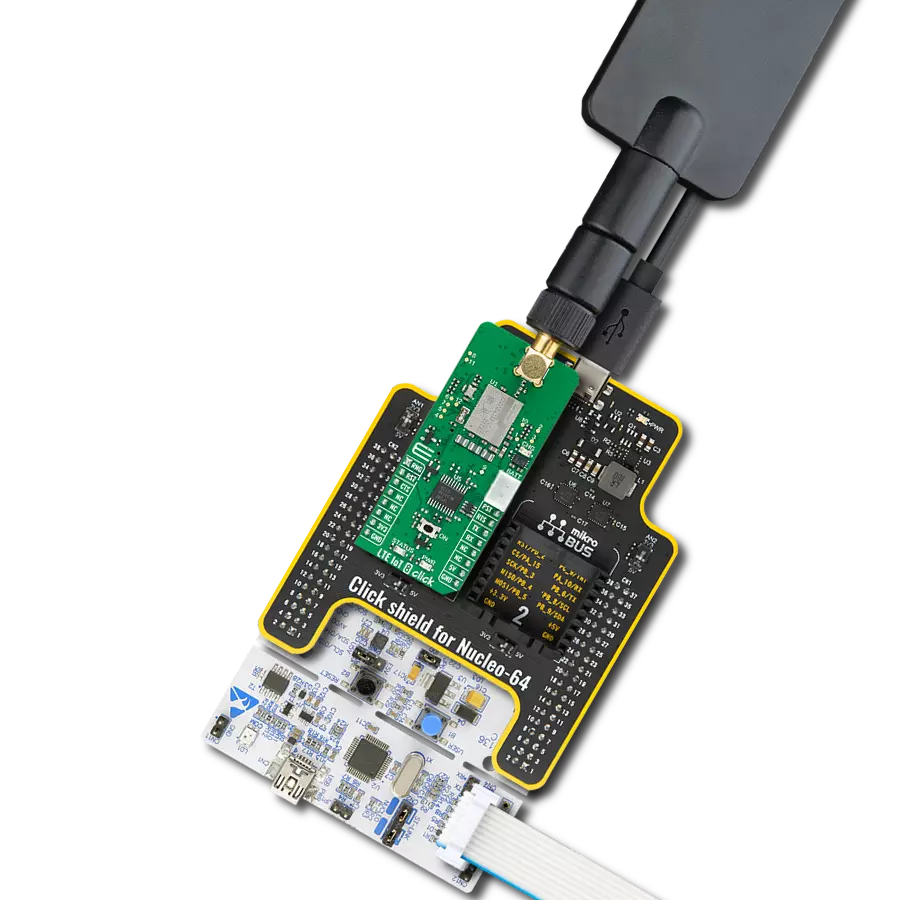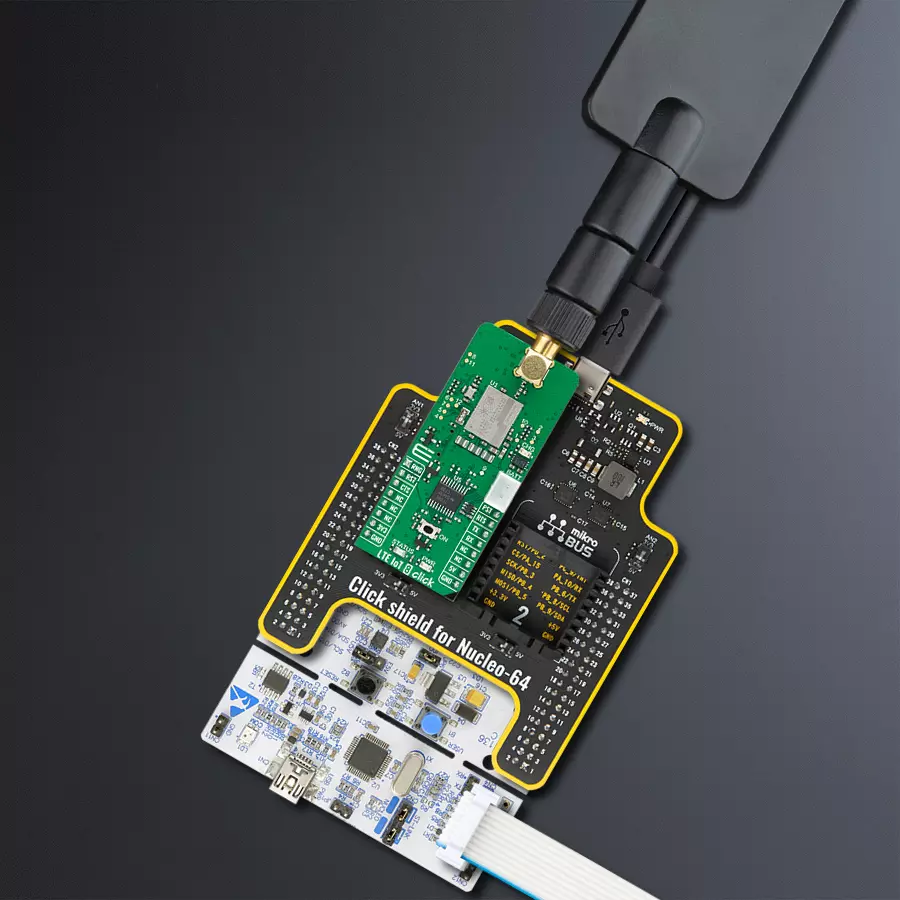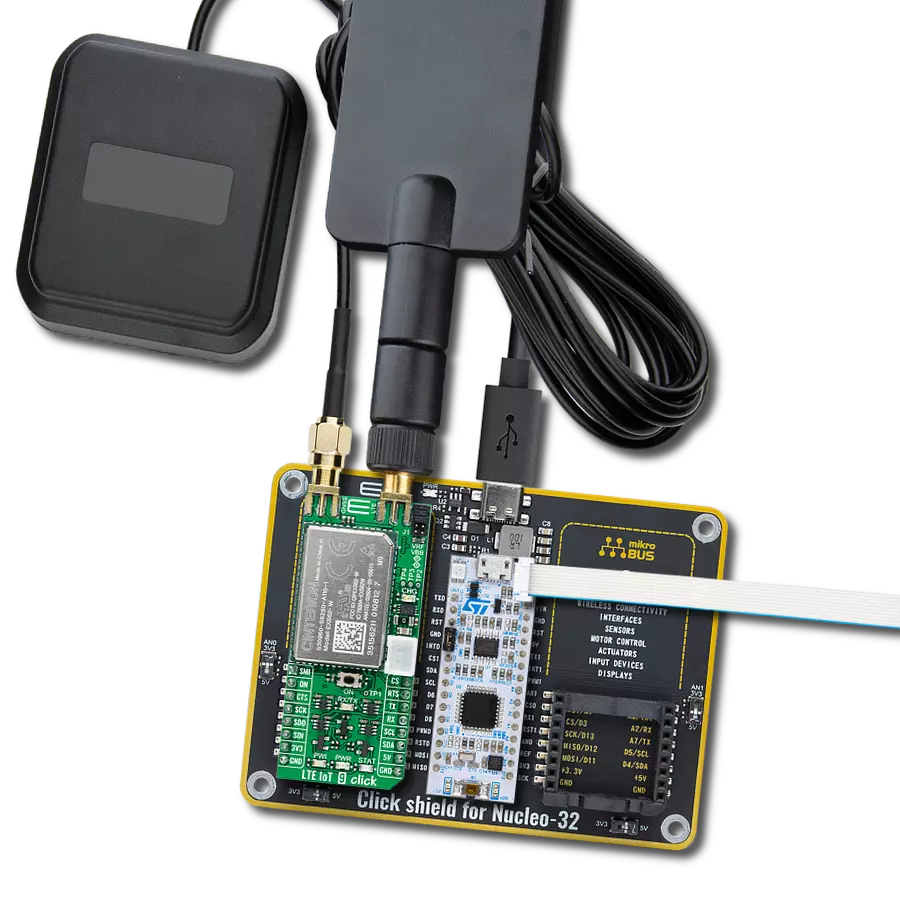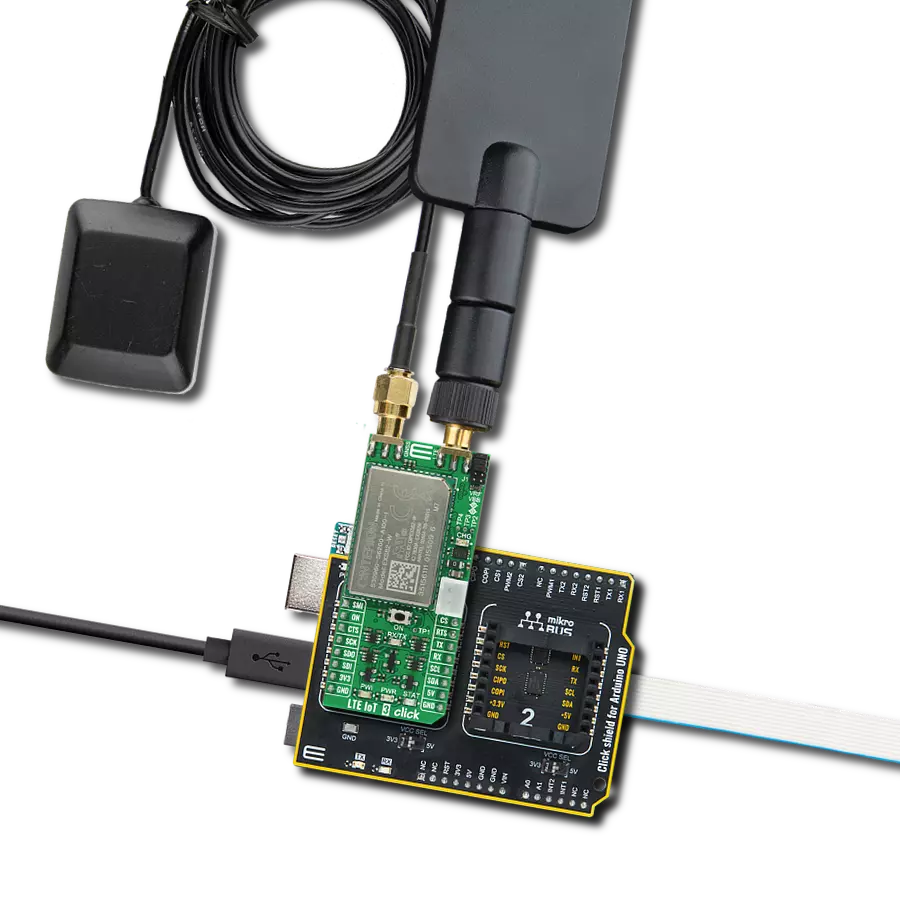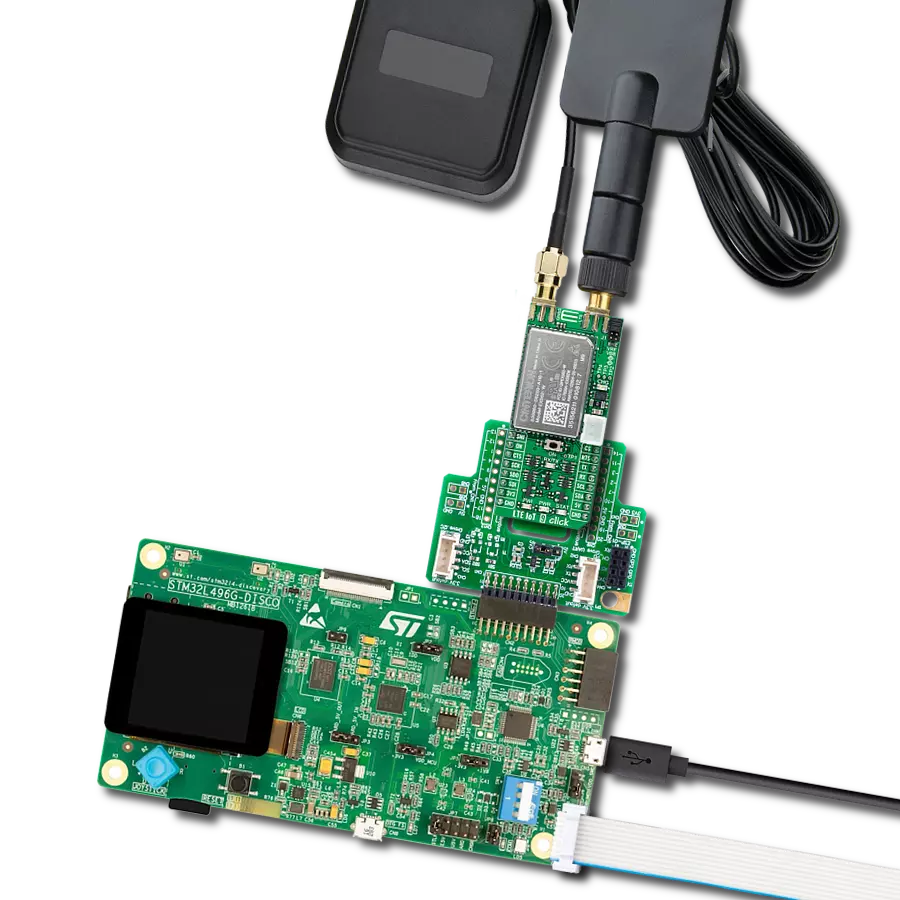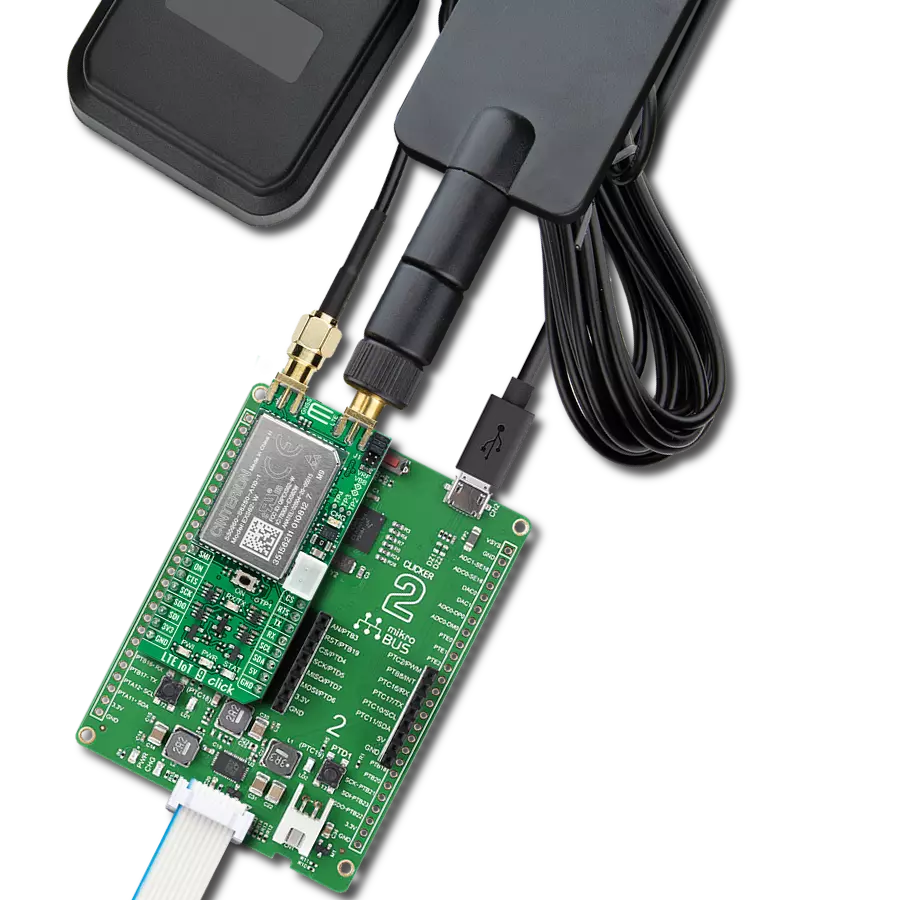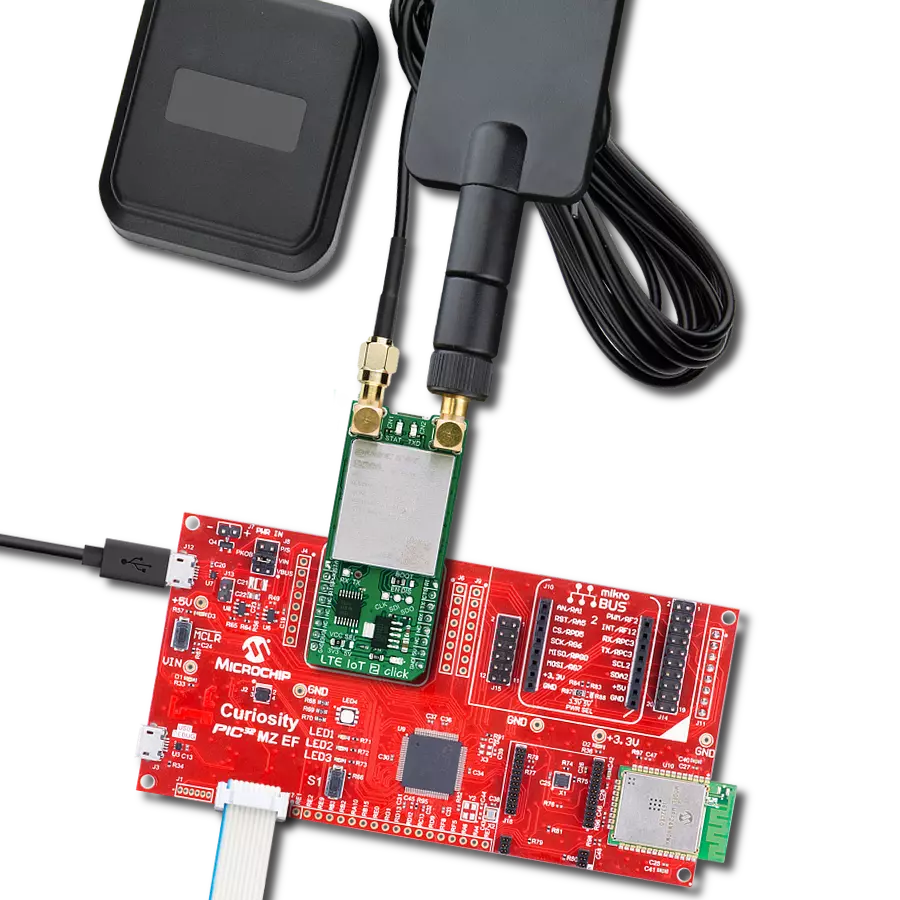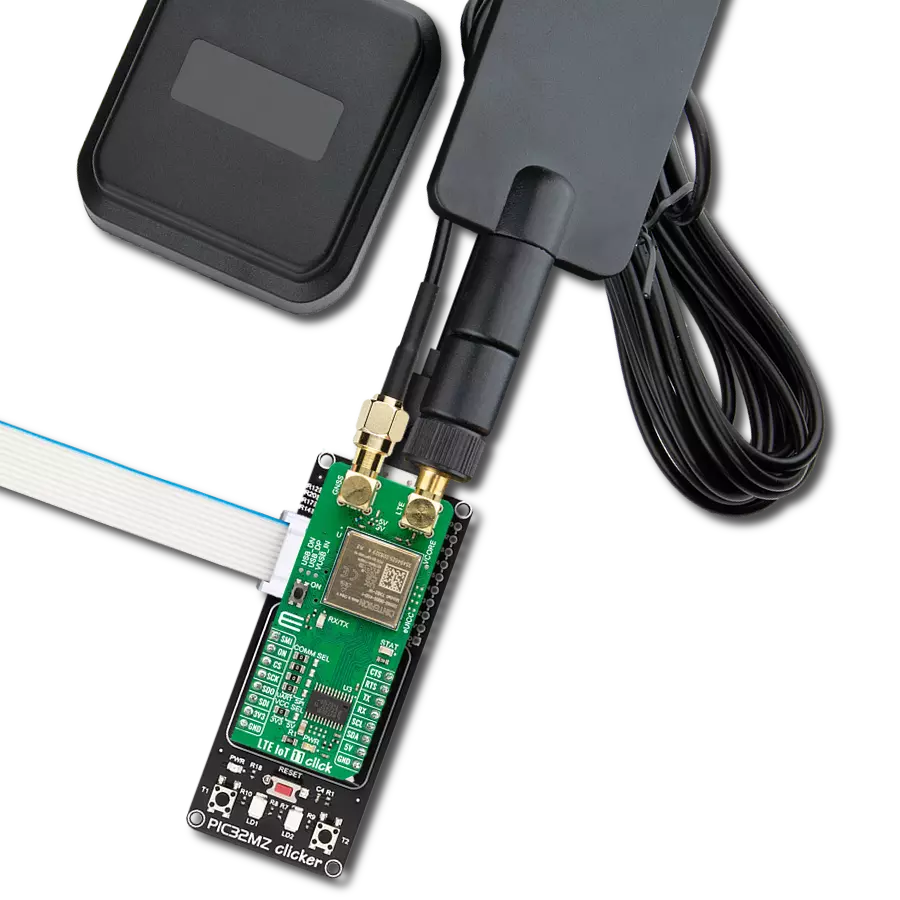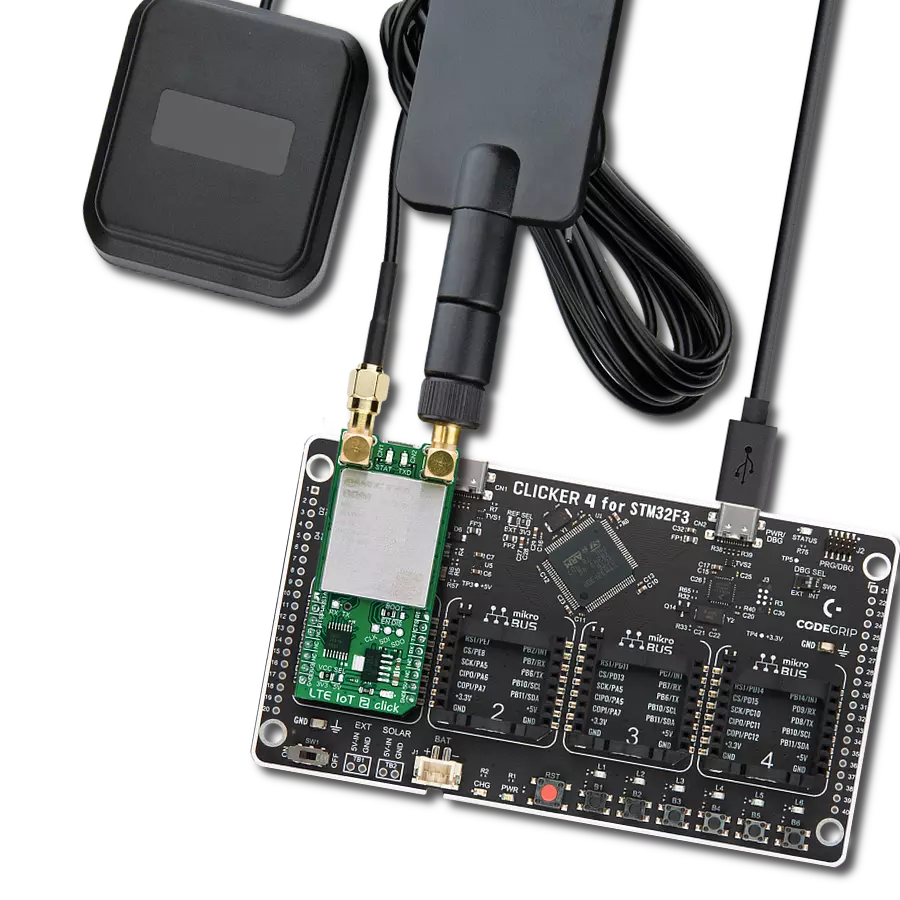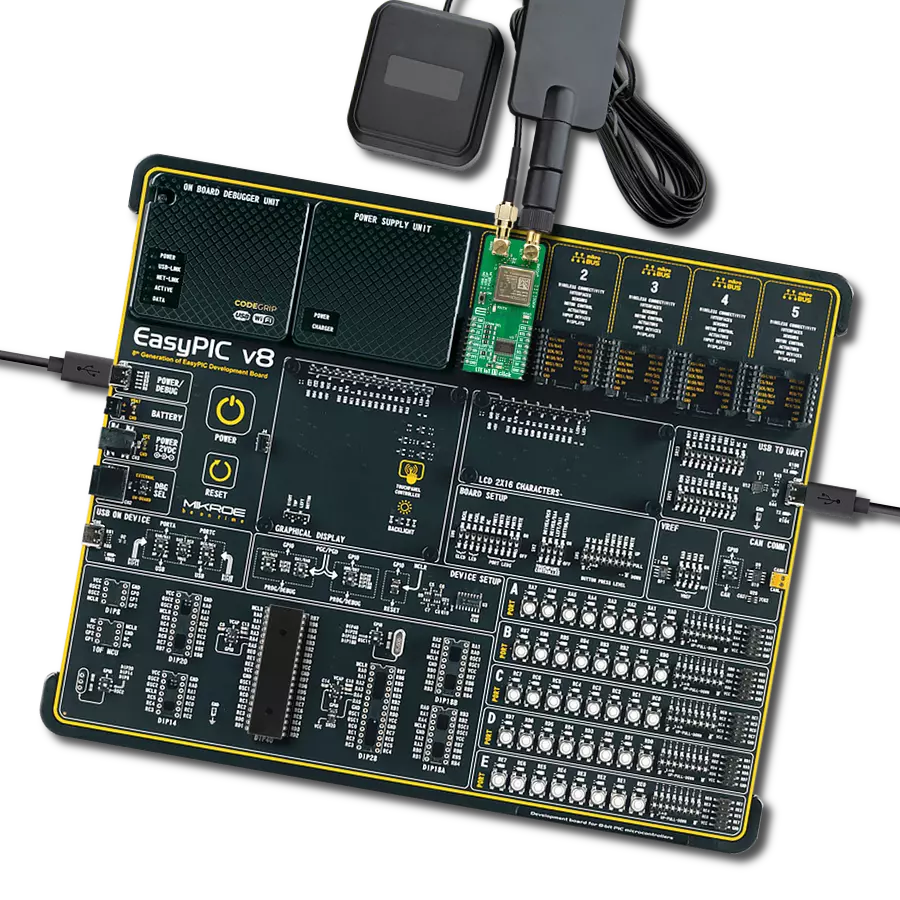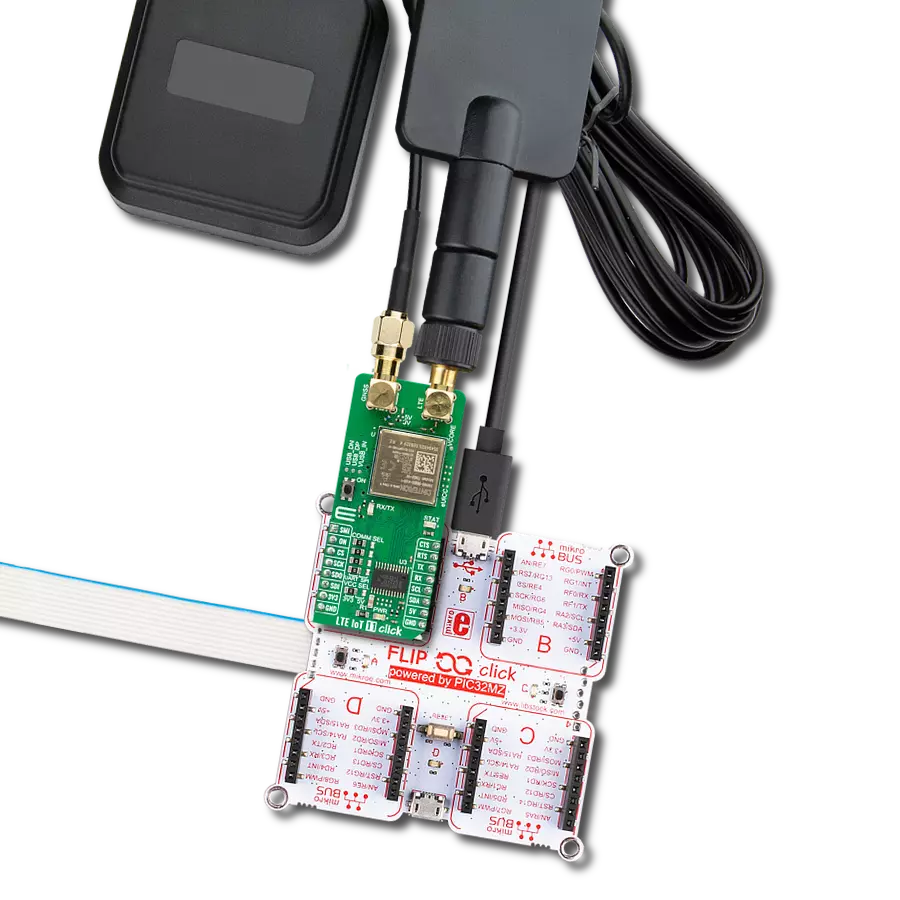Experience a transformation in IoT communication with LTE IoT, as the integration of CAT M1 and NB1 technologies delivers robust and future-proof connectivity solutions
A
A
Hardware Overview
How does it work?
LTE IoT 8 Click is based on the SKY66430-11, 5G Ready IoT SiP, compact low-power solution for LTE-M and NB-IoT connectivity in wearables, asset tracking, industrial monitoring, and smart metering from Skyworks Solutions and Sequans Communications. The SiP integrates the RF front-end, transceiver, baseband modem, memory, and power management, providing 18 bands from 698 to 2200MHz. It is pre-certified with major network operators, regulatory agencies, and standards organizations for fast global deployment. The device offers up to 300kbps download and 375kbps upload, supporting Positioning over LTE. It also has the best-in-class “Deep Sleep” power consumption of 1uA, representing a significant benefit for battery-powered IoT devices. Besides, it features a 100% software-based low-power secure positioning solution that works anywhere (enables location deep indoors where GPS doesn’t work). The SKY66430-11 communicates with MCU using the UART interface with commonly used UART RX and TX pins with the hardware flow control pins
UART CTS, RTS, RI (Clear to Send, Ready to Send, and Ring Indicator). It operates at 115200 bps by default configuration to transmit and exchange data with the host MCU. It is also equipped with a USB type C connector, which allows the module to be powered and configured by a personal computer (PC) using FT2232D, a compact USB to a serial UART interface device designed to operate efficiently with USB host controllers. This Click board™ can be battery-powered and used as a stand-alone device. It also contains the MC34671, a fully-integrated Li-Ion or Li-Polymer battery charger allowing a battery charge when Click board™ is inserted in a mikroBUS™ socket or plugged into a USB port with the CHG LED indicator used as an indicator of the charging progress. CHG LED will turn off once the battery charging is finished. Also, this Click board™ has an additional yellow LED labeled as STAT that indicates different operating modes of the module, while the PWM pin on the mikroBUS™ socket is used as a Power Saving Status
indicator. This indicator is set to a high logic state when the modem is active or a low logic state when the modem is in low power mode. An onboard pushbutton labeled ON is routed to the RST pin on the mikroBUS™, representing the Ignition button. LTE IoT 8 Click has the SMA antenna connector with an impedance of 50Ω for connecting the appropriate antenna that MIKROE offers. Besides the LTE SMA connector, this Click board™ has a Nano-SIM card slot that provides multiple connections and interface options. This Click board™ can operate with both 3.3V and 5V MCUs. Appropriate voltage level translator TXS0108E performs a proper logic voltage level conversion while the onboard LDOs ensure the recommended voltage levels of the power module. However, the Click board™ comes equipped with a library containing easy-to-use functions and an example code that can be used as a reference for further development.
Features overview
Development board
Nucleo-64 with STM32G071RB MCU offers a cost-effective and adaptable platform for developers to explore new ideas and prototype their designs. This board harnesses the versatility of the STM32 microcontroller, enabling users to select the optimal balance of performance and power consumption for their projects. It accommodates the STM32 microcontroller in the LQFP64 package and includes essential components such as a user LED, which doubles as an ARDUINO® signal, alongside user and reset push-buttons, and a 32.768kHz crystal oscillator for precise timing operations. Designed with expansion and flexibility in mind, the Nucleo-64 board features an ARDUINO® Uno V3 expansion connector and ST morpho extension pin
headers, granting complete access to the STM32's I/Os for comprehensive project integration. Power supply options are adaptable, supporting ST-LINK USB VBUS or external power sources, ensuring adaptability in various development environments. The board also has an on-board ST-LINK debugger/programmer with USB re-enumeration capability, simplifying the programming and debugging process. Moreover, the board is designed to simplify advanced development with its external SMPS for efficient Vcore logic supply, support for USB Device full speed or USB SNK/UFP full speed, and built-in cryptographic features, enhancing both the power efficiency and security of projects. Additional connectivity is
provided through dedicated connectors for external SMPS experimentation, a USB connector for the ST-LINK, and a MIPI® debug connector, expanding the possibilities for hardware interfacing and experimentation. Developers will find extensive support through comprehensive free software libraries and examples, courtesy of the STM32Cube MCU Package. This, combined with compatibility with a wide array of Integrated Development Environments (IDEs), including IAR Embedded Workbench®, MDK-ARM, and STM32CubeIDE, ensures a smooth and efficient development experience, allowing users to fully leverage the capabilities of the Nucleo-64 board in their projects.
Microcontroller Overview
MCU Card / MCU
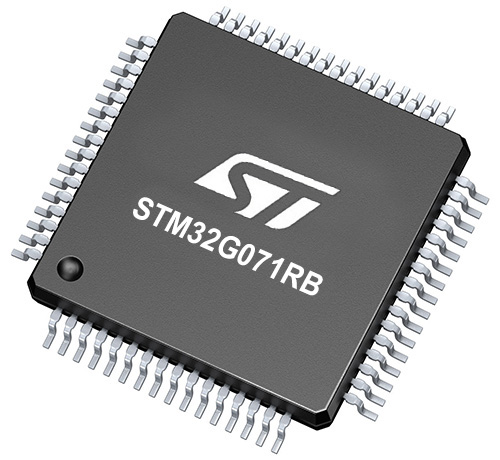
Architecture
ARM Cortex-M0
MCU Memory (KB)
128
Silicon Vendor
STMicroelectronics
Pin count
64
RAM (Bytes)
36864
You complete me!
Accessories
Click Shield for Nucleo-64 comes equipped with two proprietary mikroBUS™ sockets, allowing all the Click board™ devices to be interfaced with the STM32 Nucleo-64 board with no effort. This way, Mikroe allows its users to add any functionality from our ever-growing range of Click boards™, such as WiFi, GSM, GPS, Bluetooth, ZigBee, environmental sensors, LEDs, speech recognition, motor control, movement sensors, and many more. More than 1537 Click boards™, which can be stacked and integrated, are at your disposal. The STM32 Nucleo-64 boards are based on the microcontrollers in 64-pin packages, a 32-bit MCU with an ARM Cortex M4 processor operating at 84MHz, 512Kb Flash, and 96KB SRAM, divided into two regions where the top section represents the ST-Link/V2 debugger and programmer while the bottom section of the board is an actual development board. These boards are controlled and powered conveniently through a USB connection to program and efficiently debug the Nucleo-64 board out of the box, with an additional USB cable connected to the USB mini port on the board. Most of the STM32 microcontroller pins are brought to the IO pins on the left and right edge of the board, which are then connected to two existing mikroBUS™ sockets. This Click Shield also has several switches that perform functions such as selecting the logic levels of analog signals on mikroBUS™ sockets and selecting logic voltage levels of the mikroBUS™ sockets themselves. Besides, the user is offered the possibility of using any Click board™ with the help of existing bidirectional level-shifting voltage translators, regardless of whether the Click board™ operates at a 3.3V or 5V logic voltage level. Once you connect the STM32 Nucleo-64 board with our Click Shield for Nucleo-64, you can access hundreds of Click boards™, working with 3.3V or 5V logic voltage levels.
LTE Flat Rotation Antenna is a versatile choice for boosting the performance of 3G/4G LTE devices. With a wide frequency range of 700-2700MHz, it ensures optimal connectivity on major cellular bands worldwide. This flat antenna features an SMA male connector, making it easy to attach directly to your device or SMA module connector. One of its standout features is its adjustable angle, which can be set in 45⁰ increments (0⁰/45⁰/90⁰), allowing you to fine-tune the antenna's orientation for maximum signal reception. With an impedance of 50Ω and a VSW Ratio of <2.0:1, this antenna ensures a reliable and efficient connection. Its 5dB gain, vertical polarization, and omnidirectional radiation pattern enhance signal strength, making it suitable for various applications. Measuring 196mm in length and 38mm in width, this antenna offers a compact yet effective solution for improving your connectivity. With a maximum input power of 50W, it can handle the demands of various devices.
Used MCU Pins
mikroBUS™ mapper
Take a closer look
Click board™ Schematic

Step by step
Project assembly
Track your results in real time
Application Output
1. Application Output - In Debug mode, the 'Application Output' window enables real-time data monitoring, offering direct insight into execution results. Ensure proper data display by configuring the environment correctly using the provided tutorial.

2. UART Terminal - Use the UART Terminal to monitor data transmission via a USB to UART converter, allowing direct communication between the Click board™ and your development system. Configure the baud rate and other serial settings according to your project's requirements to ensure proper functionality. For step-by-step setup instructions, refer to the provided tutorial.

3. Plot Output - The Plot feature offers a powerful way to visualize real-time sensor data, enabling trend analysis, debugging, and comparison of multiple data points. To set it up correctly, follow the provided tutorial, which includes a step-by-step example of using the Plot feature to display Click board™ readings. To use the Plot feature in your code, use the function: plot(*insert_graph_name*, variable_name);. This is a general format, and it is up to the user to replace 'insert_graph_name' with the actual graph name and 'variable_name' with the parameter to be displayed.

Software Support
Library Description
This library contains API for LTE IoT 8 Click driver.
Key functions:
lteiot8_send_cmd- Send command functionlteiot8_set_sim_apn- Set SIM APNlteiot8_send_text_message- Send SMS message to number in text mode
Open Source
Code example
The complete application code and a ready-to-use project are available through the NECTO Studio Package Manager for direct installation in the NECTO Studio. The application code can also be found on the MIKROE GitHub account.
/*!
* @file main.c
* @brief LTE IoT 8 Click Example.
*
* # Description
* Application example shows device capability to connect
* network and send SMS messages using standard "AT" commands.
*
* The demo application is composed of two sections :
*
* ## Application Init
* Initializes driver and wake-up module and test communication.
*
* ## Application Task
* Application taks is split in few stages:
* - LTEIOT8_CONFIGURE_FOR_CONNECTION:
* Sets configuration to device to be able to connect to newtork.
*
* - LTEIOT8_WAIT_FOR_CONNECTION:
* Checks device response untill device sends information
* that it is connected to network.
*
* - LTEIOT8_CHECK_CONNECTION:
* Checks device connection status parameters.
*
* - LTEIOT8_CONFIGURE_FOR_MESSAGES:
* Sets configuration to device to send SMS messages.
*
* - LTEIOT8_MESSAGES:
* Sends message in selected mode (PDU/TXT).
*
*
* ## Additional Function
* - static void lteiot8_clear_app_buf ( void )
* - static err_t lteiot8_process ( void )
* - static void lteiot8_error_check( err_t error_flag )
* - static void lteiot8_log_app_buf ( void )
* - static err_t lteiot8_rsp_check ( void )
* - static err_t lteiot8_configure_for_connection( void )
* - static err_t lteiot8_check_connection( void )
* - static err_t lteiot8_check_connection_parameters( void )
* - static err_t lteiot8_configure_for_meesages( void )
* - static err_t lteiot8_send_meesage( void )
* -
*
* @note
* * In order for the example to work, user needs to set the phone number to which he wants
* to send an SMS, and also will need to set an APN and SMSC of entered SIM card.
* Enter valid data for the following macros: SIM_APN, SIM_SMSC and PHONE_NUMBER_TO_MESSAGE.
* E.g.
* SIM_APN "vip.iot"
* SMSC_ADDRESS_CSCA "\"+381999999\",145"
* SMSC_ADDRESS_PDU "+381999999\"
* PHONE_NUMBER_TO_MESSAGE "+381659999999"
*
* @author Luka Filipovic
*
*/
#include "board.h"
#include "log.h"
#include "lteiot8.h"
//Set valid SIM APN
#define SIM_APN ""
//Set Phone number to message
#define PHONE_NUMBER_TO_MESSAGE "+381659999999"
//Messege content
#define MESSAGE_CONTENT "LTE IoT 8 Click"
//Set valid SMSC fro SIM
#define SMSC_ADDRESS_CSCA "\"+381999999\",145"
#define SMSC_ADDRESS_PDU "+381999999"
#define PROCESS_BUFFER_SIZE 300
/**
* @brief Example states.
* @details Predefined enum values for application example state.
*/
typedef enum
{
LTEIOT8_CONFIGURE_FOR_CONNECTION = 1,
LTEIOT8_WAIT_FOR_CONNECTION,
LTEIOT8_CHECK_CONNECTION,
LTEIOT8_CONFIGURE_FOR_MESSAGES,
LTEIOT8_MESSAGES
} lteiot8_example_state_t;
static lteiot8_t lteiot8;
static log_t logger;
/**
* @brief Application example variables.
* @details Variables used in application example.
*/
static char app_buf[ PROCESS_BUFFER_SIZE ] = { 0 };
static int32_t app_buf_len = 0;
static int32_t app_buf_cnt = 0;
static err_t error_flag;
static lteiot8_example_state_t example_state;
/**
* @brief Clearing application buffer.
* @details This function clears memory of application
* buffer and reset it's length and counter.
*/
static void lteiot8_clear_app_buf ( void );
/**
* @brief Data reading function.
* @details This function reads data from device and
* appends data to application buffer.
*
* @return @li @c 0 - Read some data.
* @li @c -1 - Nothing is read.
* @li @c -2 - Application buffer overflow.
*
* See #err_t definition for detailed explanation.
*/
static err_t lteiot8_process ( void );
/**
* @brief Check for errors.
* @details This function checks for different types of
* errors and logs them on UART or logs the response if no errors occured.
*/
static void lteiot8_error_check( err_t error_flag );
/**
* @brief Logs application buffer.
* @details This function logs data from application buffer.
*/
static void lteiot8_log_app_buf ( void );
/**
* @brief Response check.
* @details This function checks for response and
* returns the status of response.
*
* @return application status.
* See #err_t definition for detailed explanation.
*/
static err_t lteiot8_rsp_check ( void );
/**
* @brief Configure device for connection to the network.
* @details Sends commands to configure and enable
* connection to the secifide network.
*/
static err_t lteiot8_configure_for_connection( void );
/**
* @brief Whait for connection signal.
* @details Wait for connection signal from CREG command.
*/
static err_t lteiot8_check_connection( void );
/**
* @brief Check connection parameters.
* @details This function checks connection parameters.
*/
static err_t lteiot8_check_connection_parameters( void );
/**
* @brief Configure device for sending messages.
* @details Configure device to send txt mode
* messages and SMSC of the SIM card.
*/
static err_t lteiot8_configure_for_meesages( void );
/**
* @brief Sending text message.
* @details This function sends text messages to predefined number.
*/
static err_t lteiot8_send_meesage( void );
void application_init ( void )
{
log_cfg_t log_cfg; /**< Logger config object. */
lteiot8_cfg_t lteiot8_cfg; /**< Click config object. */
/**
* Logger initialization.
* Default baud rate: 115200
* Default log level: LOG_LEVEL_DEBUG
* @note If USB_UART_RX and USB_UART_TX
* are defined as HAL_PIN_NC, you will
* need to define them manually for log to work.
* See @b LOG_MAP_USB_UART macro definition for detailed explanation.
*/
LOG_MAP_USB_UART( log_cfg );
log_init( &logger, &log_cfg );
log_info( &logger, " Application Init " );
// Click initialization.
lteiot8_cfg_setup( <eiot8_cfg );
LTEIOT8_MAP_MIKROBUS( lteiot8_cfg, MIKROBUS_1 );
err_t init_flag = lteiot8_init( <eiot8, <eiot8_cfg );
if ( init_flag == UART_ERROR )
{
log_error( &logger, " Application Init Error. " );
log_info( &logger, " Please, run program again... " );
for ( ; ; );
}
lteiot8_process();
lteiot8_clear_app_buf();
app_buf_len = 0;
app_buf_cnt = 0;
lteiot8_default_cfg ( <eiot8 );
while ( 0 == strstr( app_buf, LTEIOT8_RSP_SYSTART ) )
{
lteiot8_process();
}
//Check communication
lteiot8_send_cmd( <eiot8, "AT" );
error_flag = lteiot8_rsp_check();
lteiot8_error_check( error_flag );
log_info( &logger, " Application Task " );
example_state = LTEIOT8_CONFIGURE_FOR_CONNECTION;
}
void application_task ( void )
{
switch ( example_state )
{
case LTEIOT8_CONFIGURE_FOR_CONNECTION:
{
if ( LTEIOT8_OK == lteiot8_configure_for_connection( ) )
{
example_state = LTEIOT8_WAIT_FOR_CONNECTION;
}
Delay_ms ( 1000 );
Delay_ms ( 1000 );
Delay_ms ( 1000 );
Delay_ms ( 1000 );
Delay_ms ( 1000 );
break;
}
case LTEIOT8_WAIT_FOR_CONNECTION:
{
if ( LTEIOT8_OK == lteiot8_check_connection( ) )
{
example_state = LTEIOT8_CHECK_CONNECTION;
}
break;
}
case LTEIOT8_CHECK_CONNECTION:
{
if ( LTEIOT8_OK == lteiot8_check_connection_parameters( ) )
{
example_state = LTEIOT8_CONFIGURE_FOR_MESSAGES;
}
Delay_ms ( 1000 );
Delay_ms ( 1000 );
Delay_ms ( 1000 );
Delay_ms ( 1000 );
Delay_ms ( 1000 );
break;
}
case LTEIOT8_CONFIGURE_FOR_MESSAGES:
{
if ( LTEIOT8_OK == lteiot8_configure_for_meesages( ) )
{
example_state = LTEIOT8_MESSAGES;
}
Delay_ms ( 1000 );
Delay_ms ( 1000 );
Delay_ms ( 1000 );
Delay_ms ( 1000 );
Delay_ms ( 1000 );
break;
}
case LTEIOT8_MESSAGES:
{
lteiot8_send_meesage();
// 10 seconds delay
Delay_ms ( 1000 );
Delay_ms ( 1000 );
Delay_ms ( 1000 );
Delay_ms ( 1000 );
Delay_ms ( 1000 );
Delay_ms ( 1000 );
Delay_ms ( 1000 );
Delay_ms ( 1000 );
Delay_ms ( 1000 );
Delay_ms ( 1000 );
break;
}
default:
{
log_error( &logger, " Example state." );
break;
}
}
}
int main ( void )
{
/* Do not remove this line or clock might not be set correctly. */
#ifdef PREINIT_SUPPORTED
preinit();
#endif
application_init( );
for ( ; ; )
{
application_task( );
}
return 0;
}
static void lteiot8_clear_app_buf ( void )
{
memset( app_buf, 0, app_buf_len );
app_buf_len = 0;
app_buf_cnt = 0;
}
static err_t lteiot8_process ( void )
{
int32_t rx_size;
char rx_buff[ PROCESS_BUFFER_SIZE ] = { 0 };
rx_size = lteiot8_generic_read( <eiot8, rx_buff, PROCESS_BUFFER_SIZE );
if ( rx_size > 0 )
{
int32_t buf_cnt = 0;
if ( app_buf_len + rx_size >= PROCESS_BUFFER_SIZE )
{
lteiot8_clear_app_buf( );
return LTEIOT8_ERROR;
}
else
{
buf_cnt = app_buf_len;
app_buf_len += rx_size;
}
for ( int32_t rx_cnt = 0; rx_cnt < rx_size; rx_cnt++ )
{
if ( rx_buff[ rx_cnt ] != 0 )
{
app_buf[ ( buf_cnt + rx_cnt ) ] = rx_buff[ rx_cnt ];
}
else
{
app_buf_len--;
buf_cnt--;
}
}
return LTEIOT8_OK;
}
return LTEIOT8_ERROR;
}
static err_t lteiot8_rsp_check ( void )
{
uint16_t timeout_cnt = 0;
uint16_t timeout = 10000;
err_t error_flag = lteiot8_process( );
if ( ( error_flag != 0 ) && ( error_flag != -1 ) )
{
return error_flag;
}
while ( ( 0 == strstr( app_buf, LTEIOT8_RSP_OK ) ) &&
( 0 == strstr( app_buf, LTEIOT8_RSP_ERROR ) ) )
{
error_flag = lteiot8_process( );
if ( ( error_flag != 0 ) && ( error_flag != -1 ) )
{
return error_flag;
}
timeout_cnt++;
if ( timeout_cnt > timeout )
{
lteiot8_clear_app_buf( );
return LTEIOT8_ERROR_TIMEOUT;
}
Delay_ms ( 1 );
}
if ( 0 != strstr( app_buf, LTEIOT8_RSP_OK ) )
{
return LTEIOT8_OK;
}
else if ( 0 == strstr( app_buf, LTEIOT8_RSP_ERROR ) )
{
return LTEIOT8_ERROR_CMD;
}
else
{
return LTEIOT8_ERROR_UNKNOWN;
}
}
static void lteiot8_error_check( err_t error_flag )
{
switch ( error_flag )
{
case LTEIOT8_OK:
{
lteiot8_log_app_buf( );
break;
}
case LTEIOT8_ERROR:
{
log_error( &logger, " Overflow!" );
break;
}
case LTEIOT8_ERROR_TIMEOUT:
{
log_error( &logger, " Timeout!" );
break;
}
case LTEIOT8_ERROR_CMD:
{
log_error( &logger, " CMD!" );
break;
}
case LTEIOT8_ERROR_UNKNOWN:
default:
{
log_error( &logger, " Unknown!" );
break;
}
}
lteiot8_clear_app_buf( );
Delay_ms ( 500 );
}
static void lteiot8_log_app_buf ( void )
{
for ( int32_t buf_cnt = 0; buf_cnt < app_buf_len; buf_cnt++ )
{
log_printf( &logger, "%c", app_buf[ buf_cnt ] );
}
}
static err_t lteiot8_configure_for_connection( void )
{
err_t func_error = LTEIOT8_OK;
//Enable full functionality
#define FULL_FUNCTIONALITY "1"
lteiot8_send_cmd_with_parameter( <eiot8, LTEIOT8_CMD_CFUN, FULL_FUNCTIONALITY );
error_flag = lteiot8_rsp_check();
func_error |= error_flag;
lteiot8_error_check( error_flag );
//Enable device LED
#define GNSS_LEN "1"
lteiot8_send_cmd_with_parameter( <eiot8, LTEIOT8_CMD_SQNLED, GNSS_LEN );
error_flag = lteiot8_rsp_check();
func_error |= error_flag;
lteiot8_error_check( error_flag );
//Set SIM APN
lteiot8_set_sim_apn( <eiot8, SIM_APN );
error_flag = lteiot8_rsp_check();
func_error |= error_flag;
lteiot8_error_check( error_flag );
//Automatic configure cops
#define AUTOMATIC "0"
lteiot8_send_cmd_with_parameter( <eiot8, LTEIOT8_CMD_COPS, AUTOMATIC );
error_flag = lteiot8_rsp_check();
func_error |= error_flag;
lteiot8_error_check( error_flag );
//Enable network registartion
#define ENABLE_REG "2"
lteiot8_send_cmd_with_parameter( <eiot8, LTEIOT8_CMD_CEREG, ENABLE_REG );
error_flag = lteiot8_rsp_check();
func_error |= error_flag;
lteiot8_error_check( error_flag );
return func_error;
}
static err_t lteiot8_check_connection( void )
{
#define CONNECTED "+CEREG: 1"
lteiot8_process();
if ( 0 != strstr(app_buf, CONNECTED ) )
{
Delay_ms ( 100 );
lteiot8_process();
lteiot8_log_app_buf( );
lteiot8_clear_app_buf( );
return LTEIOT8_OK;
}
return LTEIOT8_ERROR;
}
static err_t lteiot8_check_connection_parameters( void )
{
err_t func_error = LTEIOT8_OK;
//Check if connected
lteiot8_send_cmd_check( <eiot8, LTEIOT8_CMD_CGATT );
error_flag = lteiot8_rsp_check();
func_error |= error_flag;
lteiot8_error_check( error_flag );
//Check registration
lteiot8_send_cmd_check( <eiot8, LTEIOT8_CMD_CEREG );
error_flag = lteiot8_rsp_check();
func_error |= error_flag;
lteiot8_error_check( error_flag );
//Check signal quality
lteiot8_send_cmd( <eiot8, LTEIOT8_CMD_CSQ );
error_flag = lteiot8_rsp_check();
func_error |= error_flag;
lteiot8_error_check( error_flag );
return func_error;
}
static err_t lteiot8_configure_for_meesages( void )
{
err_t func_error = LTEIOT8_OK;
//Set message mode
#define PDU_MESSAGE_MODE "0"
#define TXT_MESSAGE_MODE "1"
lteiot8_send_cmd_with_parameter( <eiot8, LTEIOT8_CMD_CMGF, TXT_MESSAGE_MODE );
error_flag = lteiot8_rsp_check();
func_error |= error_flag;
lteiot8_error_check( error_flag );
//Set SMSC for SIM card
lteiot8_send_cmd_with_parameter( <eiot8, LTEIOT8_CMD_CSCA, SMSC_ADDRESS_CSCA );
error_flag = lteiot8_rsp_check();
func_error |= error_flag;
lteiot8_error_check( error_flag );
return func_error;
}
static err_t lteiot8_send_meesage( void )
{
#define CMGF_PDU "+CMGF: 0"
#define CMGF_TXT "+CMGF: 1"
//Sendind message
lteiot8_send_cmd_check( <eiot8, LTEIOT8_CMD_CMGF );
error_flag = lteiot8_rsp_check();
if ( 0 != strstr( app_buf, CMGF_PDU ) )
{
lteiot8_clear_app_buf( );
lteiot8_send_sms_pdu( <eiot8, SMSC_ADDRESS_PDU, PHONE_NUMBER_TO_MESSAGE, MESSAGE_CONTENT );
error_flag = lteiot8_rsp_check();
lteiot8_error_check( error_flag );
}
else if ( 0 != strstr( app_buf, CMGF_TXT ) )
{
lteiot8_clear_app_buf( );
lteiot8_send_text_message( <eiot8, PHONE_NUMBER_TO_MESSAGE, MESSAGE_CONTENT );
error_flag = lteiot8_rsp_check();
lteiot8_error_check( error_flag );
}
return error_flag;
}
// ------------------------------------------------------------------------ END
Additional Support
Resources
Category:LTE IoT
